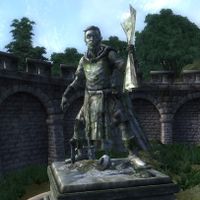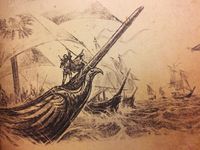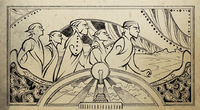
The Aldmer (meaning "First Folk" or "Elder Folk"), or Alcharyai,[1] were the original Merethic Era proto-mer who settled Summerset Isle and most of mainland Tamriel.[2] Their skin was said to have a lustrous bronze tone.[3]
They are often said to have been the first technologically sophisticated inhabitants of Nirn,[2] although some believe this distinction belongs to the Hist. The ancestors of the beast peoples such as the Argonians and Khajiit, also lived in Tamriel at the time. Though historians describe their communities of the time as aboriginal, and preliterate. Regardless of the validity of these statements, they were easily displaced by the supposedly more advanced Aldmer.[2] The Aldmer allegedly came from a lost city-continent called Aldmeris,[2][4] but a number of sources, supposedly even the revered Elder Scrolls, claim that this is pure myth.[UOL 1]
As the Aldmer spread throughout Tamriel, they evolved away from one another, physically and culturally, into the various types of mer known today. Some remained in Summerset Isle and became the Altmer.[2][5] The first emigrants to the mainland settled in Valenwood and became the Bosmer.[6] Morrowind was colonized by both the Dwemer and later the Chimer (forerunners of the Dunmer).[2] There were also the Ayleids of Cyrodiil, the Snow Elves of Skyrim, the Maormer of Pyandonea, and the Orcs or Orsimer, a group of Aldmer who worshipped Trinimac and were transformed when he became Malacath.[7] They then migrated to the province of High Rock and founded Orsinium. High Rock is also home to the Bretons, mixed-blood descendants of the native Nedes and (non-Orc) Aldmeri settlers.[8][9]
Not many Aldmer historical figures are known, but notable Aldmer include High Lord Torinaan, who first settled the Summerset Isles; Topal the Pilot, who discovered much of Tamriel; and Orgnum, a former Aldmer who is now the ageless sorcerer-king of the Maormer. Mannimarco, the King of Worms and the most famous Necromancer in Tamriel, claimed that he was not Altmer, but rather an Aldmer.[10]
The Aldmer had a "chivalric high culture",[11] but little is known of it. They were known to have their own music notation, which is reportedly difficult to read.[12]
The modern Altmer are believed to resemble the original Aldmer. The Altmer today hold their ancestors in great reverence and constantly strive to emulate their ways; it has even been alleged that they selectively breed for Aldmer-like features.[13] Some High Elf songs in modern times are written in the language of Old Aldmeris.[14]
The term Aldmeri is occasionally used as a catch-all term for all elves,[15] and is also used when referring to members of the Aldmeri Dominion.[16]
GalleryEdit
See AlsoEdit
- Aldmer Names
- For a list of notable Aldmer, see here.
ReferencesEdit
- ^ People of Morrowind — Various
- ^ a b c d e f Before the Ages of Man — Aicantar of Shimerene
- ^ Mummified Aldmer Head item description in ESO
- ^ Mysterious Akavir
- ^ Pocket Guide to the Empire, 3rd Edition: The Blessed Isle: Alinor and the Summersets — Imperial Geographical Society, 3E 432
- ^ Pocket Guide to the Empire, 3rd Edition: The Wilds Remain: Valenwood — Imperial Geographical Society, 3E 432
- ^ The True Nature of Orcs
- ^ Pocket Guide to the Empire, 3rd Edition: The Sons and Daughter of the Direnni West: High Rock — Imperial Geographical Society, 3E 432
- ^ Pocket Guide to the Empire, 3rd Edition: All the Eras of Man, A Comprehensive History of our History — Imperial Geographical Society, 3E 432
- ^ Worm Saga — Mannimarco
- ^ Provinces of Tamriel
- ^ Aldmeri Sheet Music contraband item in ESO
- ^ Pocket Guide to the Empire, 1st Edition: Aldmeri Dominion — Imperial Geographical Society, 2E 864
- ^ High Elf Songbook contraband item in ESO
- ^ Pocket Guide to the Empire, 1st Edition: Prologue — Imperial Geographical Society, 2E 864
- ^ Events of Skyrim
Note: The following references are considered to be unofficial sources. They are included to round off this article and may not be authoritative or conclusive.

